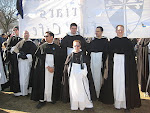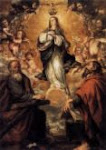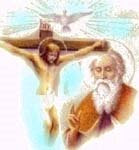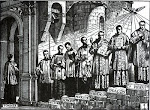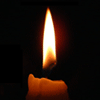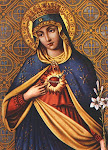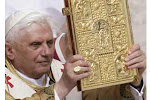

I returned from France in the early hours of yesterday, and arriving at London Stansted ,decided to visit England's nNtional Shrine of Our Lady of Walsingham. Living in the West of England and Wales, this is a very long hourney and having a complete day at my disposal, I thought I would pay a visit and managed to join a pilgrimage from Pontefract, and went to Mass at the Slipper Chapel. More of that anon in a separate post.
CharenteMy sister has a property in Montboyer near Chalais and this is directly couth of Angouleme and on the way to Chalais and thence to Aubeterre and Sainte Aulaye and this forms part of the Tours Route (from Paris and Chartres) of the Mediaeval St James Way.
O Camino de Santiago-Le Chamin de Saint JaquesI have mentioned two sites connected to St James in Monmouthshire- Saint James at Langua, which has an enormous statue of the Saint in the Church, although frequent rebuilding has perhaps eliminated the track of earlier pilgrimages and the amazing church at Orchard St James near the main A48 going to Gloucester from Tewkesbury. Most interesting were the carvings near the door of the pilgrims, who came from Mid and North Wales. Because at this period, Wales and England formed part ofte European wide Catholic Church all of whom hoped to travel to the great sites of pilgrimage in Europe, and called upon all the St James dedicated Churches en route.
This is a very informative stie:-
Aungouleme Cathedral with its absolutely magnificent facade can be googled all over, but the smaller sites from this wonderful Cathedral down to St Aulaye are interesting too.
According to this tradition St. James the Greater, having preached Christianity in Spain, returned to Judea and was put to death by order of Herod; his body was miraculously translated to Iria Flavia in the northwest of Spain, and later to Compostela, which town, especially during the Middle Ages, became one of the most famous places of pilgrimage in the world. The vow of making a pilgrimage to Compostela to honour the sepulchre of St. James is still reserved to the pope, who alone of his own or ordinary right can dispense from it. In the twelfth century was founded the Order of Knights of St. James of Compostela.
Relics at Toulouse and Compostela (Not unusual)According to another tradition, the relics of the Apostle are kept in the church of St-Saturnin at Toulouse (France), but it is not improbable that such sacred relics should have been divided between two churches. A strong argument in favour of the authenticity of the sacred relics of Compostela is the Bull of Leo XIII, "Omnipotens Deus," of 1 November, 1884.
English RoutesGenerally the English would have taken the sea route to Corunna and gone from there. However another English route runs from Bordeaux , where English and generally British pilgrims did the sea voyage. Others travelled to Paris and down through Chartres and Tours, Angouleme and visited the sites mentioned, curiously now full of English and Welsh settlers in this beautiful part of France.
My sister and Brother in Law live in a small estate just outside Montboyer, whose little Church, also on the route is dedicated to St Martial of Limoges. Curiously monks from Limoge used to live here in a building still called the monastery.
I had never heard of St Martial,but here is something about him.
St MartialUnder the Emperors Decius and Gratius (250-251 CE), Pope Fabian sent out seven bishops from Rome to Gaul to preach the Gospel: Gatien to Tours, Trophimus to Arles, Paul to Narbonne, Saturnin to Toulouse, Denis to Paris, Austromoine to Clermont, and Martial to Limoges.
Martial quickly became a beloved Bishop of Limoges, dedicating himself to evangelising the Faith and caring for the poor. In this new religion still prone to occasional persecutions and dangers, St Marial thoroughly established the Faith in Limoges and the surrounding countryside, the monks founding churches and evangelising among the people, providing healing, apothecary services for pain relievef, orphanages, doles for the poor, and corrodies-services for the elderly. They were compelled to this by the law of Christ to works of Mercy, Feed the hungry, clothe the naked, visit those in prison etc.
St Martial's Abbey- A Pilgrimage SiteMartial was buried outside the Roman town, and as his tomb became progressively more important as a pilgrimage site, the monks found patronage in the Benedictine order in the 9th century. The site became the Benedictine Abbey of Saint-Martial, a great library (second only to the library at Cluny) and scriptorium. The 12th-century chronicler Geoffroy du Breuil of Vigeois worked in its library.[2]
The abbaye de Saint-Martial, one of the great pilgrimage churches of western Christianity, was so thoroughly razed in the 19th century, that only the scattered manuscripts of its library remain. Some of the abbey's library had been bought for Louis XV and have come to the Bibliothèque Nationale de France. The original crypt was exhumed in 1966–1970. Twelve Romanesque carved capitals were discovered built into the foundations of a barn and purchased in 1994 for the Museum of the Bishopric of Limoges.

St Martial's reputation for a greatly loved Saint of Limoges has been perpetuated with his inclusion in the town crest of Limoges.
The little Churh in Montboyer is a small part of this larger enterprise.

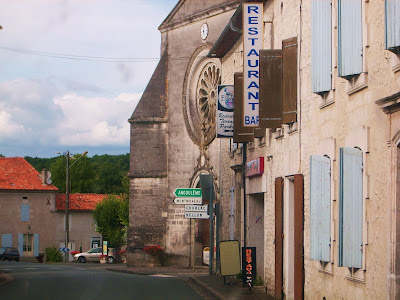
____________________________
I hope eventually to have images of the inside of the church, and the facade, but did not have a car on my recent excursion.
La Chapelle des Templiers in Cressac (near Banzac)
This is an incredible place to visit and is south east of Angouleme.


At the side of the Church, dedicated to the Blessed Virgin Mary, but used and maintained by a Protestant sect, you can still see the stone on the North Side, and the imprint of the many hands placed there through the centuries by the pilgrims on St James Camino.We visited in the 'opening hours' between 3 and 6pm in the months of August(view by appointment 05 45 64 07 31 or 06 60 83 92 12.
The Secret ChapelAfter the supressions of the Templars and their cruel and unjust executions. the church was used as a barn by local farmers. In fact theur remained undiscovered all through the 30 Years Wars of Religion and 1900 supression, until one day, a visitor notices bright colours and that on the wall were surprising and vibrant frescoes of an attack on the Muslims who had overrun the Holy Land. Like comic strips all along the wall the story is that of the Templar attack on Krak (Castle Stronghold of the 12th century crusaders in Syria) and the victory in 1163 of the Crusaders over Atabeck at Alep.
Remember we have yet to relate on M in M about how Catholics in Monmouthshire and Gwent were recruited to the Cause of defending the Holy PLaces. Gerald the Welshman travelled right through Wales raising men and money for the campaign and it is possible that these may have contained men from Gwent.
Be sure to visit this amazing shrine, especially if you are doing the Camino.
Saint Jaques at AubeterreIt was good to see such a tidy and well used church, with a very early facade. This Church also had a nearby priory and pilgrimage centre and a Hospital as you would expect for sick pilgrims, seeking healing. This was the Saint Fracois Hospital (named after Francis of Assissi). Good to see the cloister still used by nuns.
As you enter Saint James (Saint Jaques) you have to notice the large original facade. It is all that remains of the original church of St James in this very pretty market town, and dates from 12 th century-(11 hundred and something)There are three tiers and it is all that was left after the Wars of Religion destroyed the rest of the church between 13, and 14th May in 1562, when Hugenot Protestants attacked it. The church in existance now was rebuilt in 1710. The bell tower was constructed from the ancient stone and dates from 1860.
Restoration of the FacadeThis 12th century facade was restored in 1979 and 1985 and 1993. It redeveloped the faceade to its ancient height of 18 metres 40 .
The Romanwsque style doorway is of enormous symmetry and beauty and has 3 arcades and there ae many small animals carver there.
The second Tier is charged with Christian symbolism and shows six signs of the zodiac-and this shows the destruction of the other six on the right hand side.
Taurus-The Bull- a man on ia orse being pushed by a bull!for example.
The NExt TierShows sculture of the Twelve Apostles.The central celles for the round window.
The Highest Tier This shows a man on horseback, possibly Emperor Constantine, or Charlemagne or even St James, but he is not normally shown to be on a horse.
In several places on the facade you can see the shell of St James depicted.
Behind the facade you can see how old it is.
Interesting ArtefactsIt is quite a steep climb and if you do go to visit, get someone to drop you outside. Entering down, there is a sturdy bannister and the first thing which strikes you is the amazing facade. Many of these still exist in English cathedrals, but the fact this was an important church is obvious.



_______________________________
Statues of St Mary of AubeterreAs you enter the church. you notice a modern stained glass window, which is quite colourful in 1970's style, but there is a semicircular staircase leading down, and to the right a truly lovely statue of Our Lady in front of which three Candles were burning. It lit some more and made my own petitions. This statue is very beautiful, although no attempt has been made so far to restore its colouring. She carries the Christ Child in her right hand and it seems that she was carved from stone at the clos of the sixteenth century (15 something)and was placed in a niche. Seemingly she will have been 'rescued' during the Wars of Religion a' and replaced later.

 Angels
Angels 

These are on either side of a 'Peace Altar'. Indeed the other Church of Saint John, carved out of stone on the side of the mountain also suffered a great deal in these times and of course at the time of the Revolution.There was a further persecution by the French government at the opening of the twentieth century. The church has been taking a long while to recover, yet Monmouthshire benefitted from the large number of Nuns who came to work in convents in Gwent in the 19th century, called the 'Daughters of the Holy Spirit' whose work reestablished the Catholic church in large areas of Gwent, partuclarly Monmouth, Pontypool, Usk and further afield in Brecon and Abersytwyth. Must be the Will of God.They returned to Wales from St Brieux, as it was Brioc or Trioc (to whom the Benedictine Priory Church at Malpas was dedicated) who brought the Gospel to Gaul from Wales, and lived for a whil;e on St Tecla's Island off Chepstow.Another name for him was Saint Briavel.
Ancient RelicsBehind a pillar at St Jaques is a Reliquary from glass in which ancient relics are displayed. They are defended by a grille, and this makes photography difficult, but there does seem to be a relic (of St James?) a crucifix and various other artefacts from earlier times. I did the best I could, but as it was also poorly lit, I was not very successful. It is possible there is a relic for veneration as some of St James' bones were held at Toulouse.

 The Blessed Sacrament Chapel
The Blessed Sacrament Chapel was lovely, brightly coloured statue of Our Lady, more modern but very lovely and two angels in alabaster kneeling towards the Tabernacle. This is a box or tent for carrying the consecrated wafers of the Body and Blood, Soul and Divinity of Our Lord Jesus Christ. In earlier times of persecution, they often were tents and boxes, as they needed (like the ark of the Covenant) to be removed to places of safety. IN most churches, however they are part of the High Altar and a sanctuary lamp is kept burning, to show the presence of the Lord. The Earliest Christians were convinced of the Eucharistic Feast being the actual real Presence of Christ, as the Apostles taught it to their students.
For St James Feast Day 25th July (old Calendar)
Priere
Seigneur,
sanctifiez et proteger votre peuple, alfin qu'aide par la'ssistance de votre Apotre
saint Jaques, il vous soit agreable par la regiement de sa vie, et vous serve dans un parfaite tranquillite d'esprit.
Seigneur,
que la glorieux martyre de saint Jaques, votre apotre, vous rende agreable les onblations de votre peuple, et que son intercession vous les fasse agreer , n'etant pas dignes de vous par nos propres merites.
Seigneur,
Aidez nous, s'il vout plait par l'intercession de votre apotre Saint Jaques, en la fete duquel nous avons recu avex joie vos saintes mysteres.And these are identiacal prayers to ours!Just in French.

 I shall post more details of the Camino in France tomorrow, then my visit to the Abbey at La Trappe, and then finish with my pilgrimage to Walsingham.Keep reading Mary in Monmouth-and Keep Praying!!!
I shall post more details of the Camino in France tomorrow, then my visit to the Abbey at La Trappe, and then finish with my pilgrimage to Walsingham.Keep reading Mary in Monmouth-and Keep Praying!!!







 On the 21st novembrer 1852 eight nuns and novices left the Abbey of Vaise in Lyons and arrived in Espira de l’Agly (Pyr-Or) The new religious order with the name Our Lady of the Angels prospered, built a church and built an abbey which was consecrated by his Eminence Cardinal Desprez Archbishop of Toulouse on 29th November 1883. In 1904 after the severe and repressive French laws banned all religious orders from teaching and social work, they were themselves suppressed on the 4th October and expelled from their abbey, seized by the government, just has English Abbeys 350 years earlier.Many Northern French religious orders helped with the reestablishment of the Church in Wales England, and Monmouthshire benefited from the nuns from Saint Brieux. As St Brioc had travelled to Gaul (Northern France0 to the town named after him, the nuns came to found convents all over Gwent with the powerful help and support of Lady Llanover. Pontypool, Usk, Abergavenny, and Monmouth all benefitted from their help . However this community travelled to Spain over the border, where they travelled to Herrera, an ancient Cistercian Abbey in the diocese of Burgos (on the Camino of St James)until 1923, when the repressive laws against the religious orders were repealed and it was possible to return to France. The government had already sold the Abbey at Espira de l’Agly, so the nuns had to re-install themselves in the Diocese of Perigeux and received from the government the Abbey founded in 1868 by the Trappist Cistercians of Our Lady of Port de Salut (Mayenne), which had been abandoned by them in 1910. Many of these nunneries and abbeys were schools and when the right to teach was withdrawn the brothers and sisters became destitute and had to leave. Here, however, the sisters formed their new home under the protection of Our Lady of Good Hope. They continue their prayers here and live their life of Sacrifice for the Glory of God and the Salvation of Souls.
On the 21st novembrer 1852 eight nuns and novices left the Abbey of Vaise in Lyons and arrived in Espira de l’Agly (Pyr-Or) The new religious order with the name Our Lady of the Angels prospered, built a church and built an abbey which was consecrated by his Eminence Cardinal Desprez Archbishop of Toulouse on 29th November 1883. In 1904 after the severe and repressive French laws banned all religious orders from teaching and social work, they were themselves suppressed on the 4th October and expelled from their abbey, seized by the government, just has English Abbeys 350 years earlier.Many Northern French religious orders helped with the reestablishment of the Church in Wales England, and Monmouthshire benefited from the nuns from Saint Brieux. As St Brioc had travelled to Gaul (Northern France0 to the town named after him, the nuns came to found convents all over Gwent with the powerful help and support of Lady Llanover. Pontypool, Usk, Abergavenny, and Monmouth all benefitted from their help . However this community travelled to Spain over the border, where they travelled to Herrera, an ancient Cistercian Abbey in the diocese of Burgos (on the Camino of St James)until 1923, when the repressive laws against the religious orders were repealed and it was possible to return to France. The government had already sold the Abbey at Espira de l’Agly, so the nuns had to re-install themselves in the Diocese of Perigeux and received from the government the Abbey founded in 1868 by the Trappist Cistercians of Our Lady of Port de Salut (Mayenne), which had been abandoned by them in 1910. Many of these nunneries and abbeys were schools and when the right to teach was withdrawn the brothers and sisters became destitute and had to leave. Here, however, the sisters formed their new home under the protection of Our Lady of Good Hope. They continue their prayers here and live their life of Sacrifice for the Glory of God and the Salvation of Souls. 



 ------------------------- The number of nuns here has grown to 30 and in recent years a splendid retreat house has been built where frequent retreats and conferences have been held. Although the nuns are enclosed, there is a beautiful church and the picture of Our Lady of Good Hope.The church services are all open the public and the gift shop open every morning from 10-12-30and afternoon from 2.30 to 5. The Abbey is to be found in the Dordogne, south of Aubeterre-sur-Dronne and St Aulaye. The singing of the sisters was extraordinarily sweet and I attended and filmed Nones a fifteen minute dedication at 2.15pm.You need to take your own picnic lunch to eat in the glorious grounds if you are making a short day visit.
------------------------- The number of nuns here has grown to 30 and in recent years a splendid retreat house has been built where frequent retreats and conferences have been held. Although the nuns are enclosed, there is a beautiful church and the picture of Our Lady of Good Hope.The church services are all open the public and the gift shop open every morning from 10-12-30and afternoon from 2.30 to 5. The Abbey is to be found in the Dordogne, south of Aubeterre-sur-Dronne and St Aulaye. The singing of the sisters was extraordinarily sweet and I attended and filmed Nones a fifteen minute dedication at 2.15pm.You need to take your own picnic lunch to eat in the glorious grounds if you are making a short day visit.




